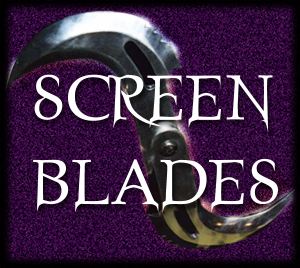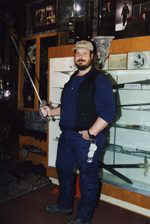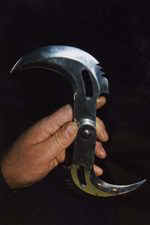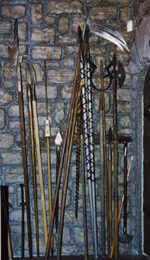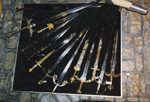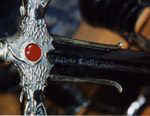IMPRESSIVE SWORD CHOREOGRAPHY IN MOVIES AND TV -- Featuring conversations with Bob Anderson, Anthony De Longis, F. Braun McAsh, Mark Ryan, Tony Swatton and Terry Walsh By Abbie Bernstein
Swordplay just doesn’t settle arguments any more – except, of course, in period films, TV shows and plays and in episodes of HIGHLANDER: THE SERIES. Indeed, what’s being taped by a video crew – and observed by a number of curious picnickers – is a re-enactment of a scene from the HIGHLANDER segment "Something Wicked." The two fellows presently going at it are F. Braun McAsh, who served as HIGHLANDER’s swordmaster on Seasons 3 through 6, and Anthony De Longis, a fight choreographer in his own right, who guest-starred as an actor in the episodes "Blackmail" and "Duende." McAsh is armed with a steel blade, which is nicking the heck out of De Longis’ aluminum sword. An array of weapons is spread out on a nearby table, awaiting use in other fights. Although HIGHLANDER ceased production after six seasons (albeit continuing in daily syndication on the Sci-Fi Channel), Davis/Panzer Productions are bringing out a BEST OF HIGHLANDER videotape set. This will include not only interviews with many of the show’s principals but also recreations of key combat sequences, with the blocking examined and explained for the benefit of viewers who until now may have enjoyed all of the metal-on-metal action with little idea of the craft behind it. Sword fights used to be a screen staple – it’s impossible to think Errol Flynn without envisioning a blade in his hand. As a glance at any PBS or A&E schedule reveals, British TV imports – everything from Shakespeare to ELIZABETH R to DR. WHO – never let up on duels. There’s been a massive resurgence lately in films (THE MASK OF ZORRO, BRAVEHEART, ROB ROY, everything Kenneth Branagh directs) and on TV (HIGHLANDER, HERCULES, XENA and their kindred), but in fact, sword fighting never completely went away. The ‘70s, after all, not only brought forth Richard Lester’s popular THREE and FOUR MUSKETEERS films (with fights choreographed by Peter Diamond), but also STAR WARS – the weapons wielded by Luke, Obi-Wan and Darth Vader aren’t called "light sabers" for nothing. "A saber," De Longis notes, "is a very powerful slashing and cutting weapon. Traditionally it’s designed to be used on horseback. It’s a very thick blade – it would smash through a small sword, so someone fighting against someone who has a saber has to keep their distance and [mustn’t] stand there to absorb all the energy of the blow. They need to be moving and dissipating that energy and deflecting the cut. Saber is the fastest of the weapons. The complexity of the attacks were considerable, because you had not only the point, but you also have the cutting edge to a full side on one side of the blade. It had a director to determine who first began the attack. The attack has right of way and must be parried before a counter can be launched. The assumption is that no one hates someone so much that they will impale themselves just so they can kill their enemy."
Of course, the technique had to be adjusted for light sabers, as it wouldn’t make much visual or physical sense for the STAR WARS combatants to try to skewer each other with the Jedi weapons. The light saber choreography in the first three STAR WARS films was staged by Bob Anderson, the British Olympic fencer who began his film career dueling in the 1953 MASTER OF BALLANTRAE. Anderson started arranging sword fights in 1957 with THE MOONRAKERS; among his more prominent credits are THE MASK OF ZORRO, THE PRINCESS BRIDE and HIGHLANDER (both the original feature film and the initial two seasons of the TV series). "There’s very little thrusting with a laser sword," Anderson says with a laugh of the STAR WARS technique. The actual fighting style is "something I made up for the light sabers – mostly slashing parries." The difference between the styles of rapiers and sabers, thrusting and slashing, are crucial to sword choreographers. "Each sword is determined by the technique that you’re fighting with," observes armorer Tony Swatton, who has crafted swords, armor and props for THE MASK OF ZORRO, WILD WILD WEST, BLADE, BABYLON 5 and CONAN THE ADVENTURER (that’s Swatton’s arm forging the blade in the opening credits). He’s also made components for the NASA space shuttle, all in the workshop he maintains behind The Sword and the Stone, his open-to-the-public shop in Burbank, CA. "A Japanese sword is a single-edged curved blade that you’re going to fight with in samurai/kendo sword techniques, which is more of a slash thing. A rapier, or a small sword like Zorro’s sword, is going to be more of a thrusting type weapon. The balance and the weight are going to be different. The CONAN sword is an exceptionally large, heroic broadsword, where you could poke with it, stab with it or slash with it. When [the producers] tell me what type of sword they want, I kind of know what techniques they’re going to use and build it accordingly. On the CONAN sword, even though it’s very heavy, it’s balanced. Balance means everything. If the blade is too heavy or the pommel, the counterweight, is too heavy on it, then you’re not going to be able to use it in your hand." For those not versed in sword culture, Swatton clarifies the term "balance point." "That’s where your hand is going to be. It’s like a fulcrum. It’s like a teeter-totter. Your hand is going to be close to the cross-guard of the hilt on the grip. So you want your balance point to be right around there. It can be two, three inches forward of the guard, if you have a heavier blade that’s going to be doing slashing. But if you’re going to be doing a lot of stabbing with it, like a rapier, you want that right on the guard. If you put your finger forward of that onto a portion of the blade that’s unsharpened called the ricasso on most rapiers and fencing weapons, you have a guard where you can put your finger forward of there. It helps you manipulate the tip, you have more tip control. I refer to it as ‘point and shoot.’ " "Some of the older, heavier swords were used primarily for cutting, literally for chopping at the vulnerable parts of the body," explains Mark Ryan, who assisted Anderson on FIRST KNIGHT and has just completed a solo stint as fight arranger on the new TV series THE SECRET ADVENTURES OF JULES VERNE. "Later on, when the rapier and dueling became very prevalent, swords became lighter. The heavier armor used in the Middle Ages wasn’t used, because firearms made it useless. So swords were [then] mainly used as thrusting weapons. You wouldn’t actually try and cut somebody with a rapier. You’d try and stab somebody with a rapier, you’d try and thrust it through their body." The heavier swords, like cutlasses and sabers, are used for cutting and for thrusting. It didn’t mean that you couldn’t thrust with them, but they were used for cutting. Whereas later, Renaissance weapons were mainly thrusting weapons, with a sharp point, long thing blade, to push through a wound into the person’s body. From that developed small sword dueling and that’s where they get modern fencing from."
McAsh has been studying bladed weaponry for most of his adult life, which came in handy when he began working on HIGHLANDER: THE SERIES. "We choreographed for virtually every weapon from the Roman Empire to the present day, which is one of the things that made the series so challenging and so interesting, because nothing could be the same twice, even if you were using the same weapon. In terms of my own preferences, I am known for my research and choreography in rapier and dagger, the Renaissance forms of combat from the early 1500s to the mid-1600s, when the rapier got replaced. The rapier is used with so many other ancillary weapons – the dagger, the buckler shield, the weighted cloak, the two-rapier style – so there’s a tremendous amount of variation, especially because during that period there was a big argument going on as to which was more important, the edge or the point. Resolving that question led to the changing shape of the rapier, as the point became the predominant thing and the edge became less important and that stylistically affected how the rapier was used." On ZORRO, Anderson used moves compatible with the characters’ rapiers, with some modifications. "Competitive fencing is extremely fast. When [the combatants] attack, it’s so fast it’s over before you can see it. That’s why fencing is not a spectator sport any more. The speed acquired by good actors, well-trained actors, is a speed at which people can see what’s happening on film. If you say what they did when the director says, ‘Action!,’ you would think it’s exceedingly fast, but to me or to the actors, it’s not, because they’re so well-rehearsed. We fenced with rapiers – mock-up rapiers, anyway – and the fights were controlled by that fact, but you always put in a few cuts and thrusts when you’re doing a film fight. You try to appeal to the basic style of the sword. If you’re using a cutlass, it’s what I call hack-and-bash fencing. You swing on a rope across to the other ship and you slash at anything in sight. The sequences are not very long and you’re not bothered about style or technique – you don’t try and make it authentic – well, it is authentic with a cutlass, because that’s all they did do, was hack and bash," he adds with a chuckle. "But when you’re dealing with a sword like a rapier, you’ve got to have style. You can’t stick to rigid classical styles of swordplay. I mean, if I tried to stick to swordplay as it was in the eighteenth/nineteenth centuries, it would be very boring on film. Two people facing each other first thing in the morning under dripping trees with sharp swords and going to kill each other, they’re not going to do a lot of engaging, are they? They’re going to wait for an opportunity when the opponent makes a mistake, and then get in there and stab him. Well, of course, you can’t afford the film time for that sort of thing, so you fill it all in with exciting and almost impossible swordplay, which they couldn’t possibly do if it was for real. I don’t think anybody could do what [Antonio] Banderas [as Zorro] did in that final fight with Captain Love [Matthew Letscher]. I think what I gave the actors in ZORRO was style. I hoped I showed that there was a certain amount of technical skill behind it all, and also thought. So when you’re engaging somebody, and you can go through a repertoire of attacks, parries and ripostes the way they did, it has something in it other than just hack and bash."
In the case of ZORRO’s cast, they also had practice, Anderson says. "They rehearsed and rehearsed and rehearsed, not only before we started shooting, but also every time they were free on the set. They learned it like you learn dialogue; you keep doing it until you’ve got it right. You then put it into context and put the emphasis in, and it comes out making sense." Sword choreography is a specialized line of work with relatively few practitioners. "There is a fairly large group of people who are professional fight directors," McAsh relates, "The Society of American Fight Directors and the Society of Canadian Fight Directors and the British Society over in England. There actually is a peer group, although when you compare it to actors or directors, it is a substantially smaller peer group. We are sort of unique. Speaking from a professional point of view, I think in a way it’s almost beneficial to compete with the smallest number of people possible for what are basically a very, very small number of jobs. But on the other hand, there’s not really that much feedback per se, so you just are to accept that you are doing your job to the best of your ability at this particular stage in your development and that you will get better as you get more experienced and get more information as time goes on, because it’s one job where you never stop researching." The sword choreographers interviewed for this article all took different routes to their craft. Anderson began studying fencing while aboard ship as a member of the Royal Marines during WWII. "I took to it like a duck to water," Anderson remembers. "I took it under the French Olympic coach, and he thought I had talent, so he asked if he could train me for Olympic fencing and also as a fencing coach." Anderson made the British Olympic team in 1952 and was British Amateur and Professional Saber Champion. "I think a sport takes you up, you don’t take it up – in the sense that you try a lot of sports and then there’s one that you become good at right from that beginning. And that’s the one you do, because you find your success is quicker. Everybody enters these things in order to be successful. And so fencing took me up – I finally knew where I was. It was only much later, when I retired from amateur fencing, that I began to enjoy the choreography of fight sequences. Up until then, I was a good stunt man as well, but I used to do mostly fencing." For Terry Walsh, a British veteran who most recently blocked the sword work on A&E’s SCARLET PIMPERNEL miniseries, the stunt/fencing route ran the other way. After failing in his third year of studying to be a research chemist, followed by a stint in the army, "I just couldn’t face going back and having to go to school for the rest of my life. I fell into the film business. A fellow I knew phoned me up one day and said, ‘Look, I’ve got some Land Rovers and there’s an Army sequence and I need them delivered. Can you deliver one for me to the set?’ So I said, ‘Yeah, sure.’ " That got Walsh as far as the studio. "I saw the father of the British stunt industry, a guy called Paddy Ryan, doing a 50-foot fall. I thought, ‘If they’d asked me to do that, I wouldn’t have known how.’ So I approached him and he agreed that he would teach me. So the next two years, every time he worked – which was a lot – he would phone me up. I would take him to the studio, he would show me what the job was, he would explain the various ways that it could be done, the way he was going to do it and why, and then when it was lunch time and there was nobody about, he’d make me do it until it was done to his satisfaction.
"Then I managed to get into the Havoc Agency, which was an agency for stuntmen," Walsh explains. "I worked for the BBC a lot. I was doing DR. WHO when Jon Pertwee became the Doctor, and it was realized that I was a very good stunt double for him. Not that long afterwards, I was offered the show as stunt coordinator. It’s all done on video, so you have instant rushes, so you can actually learn very quickly by your own mistakes and you can learn shot composition and economy. I looked and the film and television industry at that time and discovered that there were very few fencers or swordsmen. I could see there was a huge gap in the market. So I studied for about three years, two nights a week, and then feature films started to make noises and offer me what seemed like huge amounts of money. I think the first big feature film I worked on was THE OMEN, did a dog sequence in that. Once I’d sort of got a very good basis [in sword technique], I played with it a lot, and I developed the technique that I still use. An awful lot of fencing, regardless of what you’re doing, there’s a lot of clever stuff that the audience won’t see unless you make a point of going into slow motion and showing how clever it is. So I developed a very simple style." McAsh has always had a fascination with blades. "If you look at a sword, there is an innate desire to want to pick it up and swing it about and see what it will do, so there is a visceral aspect to the study of weapons and weapon technique. This developed more or less simultaneously with wanting to be an actor and then as an actor performing fights. When I was in theatre school, between 1972 and 1976, I was a saber fencer for the university team. The last two years of theatre school, we had theatrical sword-fighting, and I started doing choreography for the theatre school when I was in a play that had a swordfight in it, because I had more training with the sword, because had more experience with the sword than anybody else in the theatre school at that particular time. I was a fencer. Mind you, that is completely antithetical to theatrical choreography. Competitive fencing is designed to actually hit and to move very fast – the two things that you just do not do in theatre." Like McAsh, De Longis is still an actor – he has a recurring role on STAR TREK: VOYAGER and has appeared a plethora of films and TV episodes including BATMAN RETURNS, MASTERS OF THE UNIVERSE, Walter Hill’s WILD BILL, BABYLON 5 – but for him, fencing grew out of a need for physical recovery. "I was very unathletic," De Longis recalls. "I sustained a fairly severe injury – I broke my back when I was about 16 when I was unloading some heavy equipment and I got pinned. I decided I was going to make some changes in my body, so I started to lift weights and it was the first indication that if you worked hard on something, you can make a change, you can be responsible for what happens to you. So from that standpoint, it was a nice metaphor, so I got strong – but I still didn’t know anything. The parts didn’t really move together very well. I went into fencing. It taught me balance, things moving as a unit, which is of course necessary to be able to construct a character. I found that I liked it and I was good at it – I ended up winning the Pacific Coast championships and the Western Intercollegiate Fencing championships in my senior year. Also, as a boy, I liked Robin Hood, went out and hammered a couple of pieces of wood together and flailed around and had a wonderful time. I’ve never really forgotten that feeling. I think it’s part of the joy that a good action scene offers an audience. Fencing became the first disciple that I studied that made sense to me, both in terms of ‘This is something I should know’ and ‘This is fun – and my God, there’s a need for this out there, because most of the [onstage] sword choreography is just God-awful!’ " He laughs. "A lot of what I call ants-and-airplanes, windshield-wiping flailing about. It just doesn’t mean anything. To me, if action doesn’t drive a story forward and articulate a character, it’s basically a waste of time for both the performers and the audience. All of this didn’t come to me in one single epiphany," he laughs again, "it’s been a growing process."
For his part, Ryan recalls, "I had a natural affinity for [swordplay], but I didn’t consciously think, ‘I’m going to have this as a tool which I’m going to end up using in my career.’ I’m very happy that I have and where it’s led me, but [when starting out], I thought I was destined for a career in West End musical. I just did the stuff that I enjoyed, i.e., horses and a bit of archery and a bit of swordplay, and then I was lucky enough for it to actually come in handy, not just to use, but for it to become a main part of what got me the work." Ryan wound up choreographing a knife fight when he was cast in a role in a production of DEAN in London’s West End. "The guy that was choreographing the dancing was trying to show me these knife moves and he discovered that I knew more about it when he was challenging me to take the sword out of his hand – he was throwing it from hand to hand and I just flicked it out of his hand and caught it and he went, ‘Oh, you know more about this than me – you’d better do this.’ " Ryan went on to originate the role of Magaldi in the first-ever production of EVITA and later played Che in the musical for a long run, but returned to working with blades when he was cast as the Saracen Nasir in the HTV series ROBIN OF SHERWOOD. During three seasons on the series, as a character whose trademark is using two swords simultaneously (one in either hand), Ryan learned a great deal about swordplay from the show’s stunt/sword coordinator – Walsh. "Terry was brilliant," Ryan enthuses. "We used to have two weeks’ training for each season, and we did it virtually every day, so on the set, if we weren’t acting, we’d probably be training for a big sword fight. Terry had six enthusiastic young men [Robin and five Merry Men] on his hands and he very cleverly let us do what we thought we wanted to do without it seeming that he was controlling the situation, although he was. If Terry said, ‘You can’t do that,’ we didn’t do it. First of all, you need an outside eye to view what is going on. And Terry was brilliant at that. He let us do our best work, but he kept it under control. We did come up with some of our own stuff, but he had a great eye for angles and shots, and often he would suggest things and we’d go, ‘Why do you want that?’ and he’d go, ‘Trust me.’ And when you saw it, you understood why. He also choreographed some great stuff." One of these is the gymbal: "A gymbal," Ryan explains, "is when you get into a sword lock, when you see the baddie and the goodie going, ‘Arrggh,’ very close, face to face, with the cross-pieces of the swords locked together – they gymbal around a little bit. It’s usually so you can get into the close-up." Indeed, Walsh’s routines known as "Robin Hood 1, 2 and 3" have passed into the British film fencers’ vernacular. "I would say that almost every stuntman knows them," Walsh acknowledges. "They’re basically very simple routines which are flexible, they’re open-ended, so you could do them twice, or I could do it to you, you could do it back to me, or I could do it to you and then you could say, ‘Right, I’ll start with 3 and do the first two last.’ I knew that on ROBIN, I was going to be tight on time. So therefore I thought the best thing to do was to teach all of the stuntmen and the actors the basic ‘Robin Hood 1.’ So when they’d suddenly say, ‘Oh, quick, get a fight over there,’ you’d say, ‘Right, go and do Robin Hood 1 over there, finish it off with a swish and a cut.’ " And they’d go and do it, rather than me saying, ‘Well, I just have to have some rehearsal time.’ Obviously, I didn’t use Robin Hood 1 all the time, but it was there if it was needed."
There is a Spanish style of sword study and combat known as the Mysterious Circle, a term that might also apply to the interwoven paths of sword masters. Ryan learned a great deal about swordplay from ROBIN’s stunt/sword choreographer Walsh during their three seasons with that series. When Ryan subsequently won a small role in the Sean Connery/Richard Gere Camelot drama FIRST KNIGHT, sword master Anderson liked Ryan’s work so much that he offered the actor a film-long gig as the assistant sword master – with Walsh pitching in as well on a few sequences that had up to 500 fighters needing guidance. "Bob is Mr. Zen when it comes to swords," Ryan says appreciatively. "The man is now in his 70s and still as sprightly and as fit and as witty and as charming and as erudite as you could wish for. And just a brilliant swordsmaster. He was able to keep control. I think it’s because he studied as a coach, he’s studied sports psychology and he really knows people’s minds, he can understand what’s motivating them." As Anderson had left HIGHLANDER: THE SERIES to do FIRST KNIGHT, McAsh was hired as sword choreographer on the series, where he met De Longis. De Longis later applied for the ZORRO sword master gig early on, when Robert Rodriguez was set to direct. The research De Longis did ultimately led him back to HIGHLANDER and McAsh. Click here to read Part 2 of this article. ISSUE 16.0 – MAY 7, 1999
|
